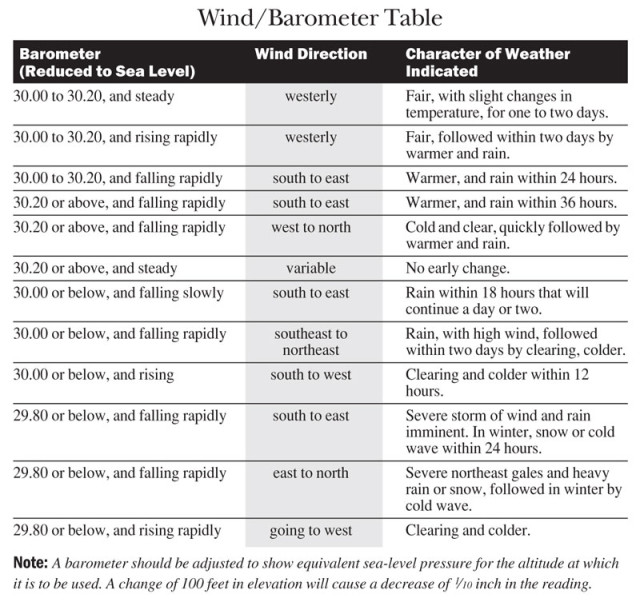Using Atmospheric Pressure and Short-Term Changes for Weather Prediction

|
Ads we feature have been independently selected and reviewed. If you make a purchase using the links included, we may earn a commission, which helps support the site. Thank you for your support.
Getting the weather forecast or current conditions these days is easier than ever and we have become somewhat complacent about it (yawn, yawn). Just check one of the many sites on the internet. One hour from now, no problem. 10 days from now, likewise. If you want conditions and a forecast for a very specific area, such as your home or neighborhood, go with a personal weather station (PWS).
In the old days, tools like the barometer had to be used to anticipate rain or storms in the near future. Your PWS, in fact, has barometric functionality. Electronic pressure sensors measure pressure utilizing a force collector which measures the strain resulting from an applied force over an area. Changes in electrical resistivity of a semiconductor or metal are measured when a mechanical strain is applied. The resulting voltage output may be analog, which can be converted to digital.
What is Atmospheric Pressure?
First, a little conceptual science. Atmospheric pressure (barometric pressure) is just the weight of air at ground level. Consider the concept of water pressure as an analogy. The deeper you get in the water, the more the pressure increases because as you go down, the built-up weight of the water above you increases.
Consider land as being the bottom of your atmospheric sea. Air is actually not weightless although in daily life it seems so. Atmospheric pressure is the weight of the air from the top of the atmosphere straight down to you; a column, if you will. As you might imagine, pressure is lower as you get higher in elevation because there’s less air on top of you.
This pressure measurement is usually made in hectopascals which is in effect a measure of pounds per square inch. On any modern consumer barometer, the measurement will be indicated in either inches or millibars.
Forecasting the Weather With a Barometer
If you have an aneroid device, you’ll need to manually calibrate it. It’s easy; all this entails is adjusting a small screw on the back to set the hand, like on a clock, to match the current barometric pressure where you are. weather.gov is very comprehensive by zip code. Once you’ve done that, it’s all set. Digital barometers do this step for you.
Barometer measurements are either in inches or millibars. Your readings will usually be between 28 and 31 inches, generally measured to the hundredth decimal. However, the number itself isn’t going to help you much. The thing to focus on is which direction the numbers are moving. You’re looking for the change in barometric pressure to forecast the weather. What does this mean? The static numbers that exhibit no indication of rising or falling aren’t very useful. So, you need to keep up with the change.
Aneroid barometers have two hands. One shows the barometric pressure reading The other one is a manual dial that you align with the pressure reading at the time that you take a measurement. This way you can quickly and easily see which direction and how far the needle has moved between your readings.
Digital barometers usually have indications of “rising” or “falling,” and some models even display a graph called a barograph showing earlier readings and trends. This is more helpful and accurate for you, the amateur meteorologist. Instead of having to write down or memorize previous readings, your device does it for you.

Those are the basics of using a barometer. The more you use it, the more adept you will become at understanding weather patterns in your location. Other than just doing it as a hobby, knowing how conditions are changing is very useful for work and outdoor recreational activities.
Trending Articles
- Ambient Smart Wi-Fi Weather Station Product Review
- Rainwater Harvesting 101
- Al Gore– The P.T. Barnum of Climate Change
- The Richard Feynman Learning Method
- A Fundamental Guide to Long Runs
- Cheesy Chicken Enchilada Recipe
- Common Causes of Mood Swings
Looking for more great content? Visit our main page or partner sites:
I offer article and blog-writing services. Interested? Contact me for a quote!
Did you find this article helpful? Millions of readers rely on information on this blog and our main site to stay informed and find meaningful solutions. Please chip in as little as $3 to keep this site free for all.








 Kelly R. Smith is an Air Force veteran and was a commercial carpenter for 20 years before returning to night school at the University of Houston where he earned a Bachelor’s Degree in Computer Science. After working at NASA for a few years, he went on to develop software for the transportation, financial, and energy-trading industries. He has been writing, in one capacity or another, since he could hold a pencil. As a freelance writer now, he specializes in producing articles and blog content for a variety of clients. His personal blog is at
Kelly R. Smith is an Air Force veteran and was a commercial carpenter for 20 years before returning to night school at the University of Houston where he earned a Bachelor’s Degree in Computer Science. After working at NASA for a few years, he went on to develop software for the transportation, financial, and energy-trading industries. He has been writing, in one capacity or another, since he could hold a pencil. As a freelance writer now, he specializes in producing articles and blog content for a variety of clients. His personal blog is at 







